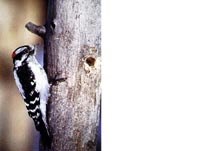
Located at the southern tip of Lake Michigan, the Indiana Dunes National Park is an important feeding and resting area for migrating birds. The national park is in the top five of all national parks in terms of the number of recorded bird species with over 350 confirmed species. Lake Michigan influences the migration patterns of bird species. During the fall migration, southbound birds follow the north-south shoreline and are funneled into Indiana's dunes. Also, the expanse of open water and miles of shoreline can attract large numbers of wintering birds. Indiana Dunes National Park provides an excellent opportunity for birders to see a variety of bird species. Birders can watch birds along the shoreline with a spotting scope, stand on the foredunes observing the hawks during migration, or look for wetland birds in remnant sections of the Great Marsh. Whether you have beginner or advanced identification skills, the national park is a great place for birders. The national park conducts annual monitoring of birds at several different park locations.The monitoring is focused on tracking population trends of breeding birds. Monitoring programs provide valuable data on the status of birds in the park and also contribute to national efforts to track bird populations. 
NPS Photo Songbird MonitoringThe North American Breeding Bird Survey (BBS) is the primary source for critical quantitative data to evaluate the status of continental bird species, keeping common birds common and helping fuel a $75 billion wildlife watching industry. Each year thousands of citizen scientists skilled in avian identification collect data on BBS routes throughout North America allowing us to better understand bird population changes and manage them. The USGS Eastern Ecological Science Center, Environment and Climate Change Canada, and the Mexican National Commission for the Knowledge and Use of Biodiversity jointly coordinate the program, which provides reliable population data and trend analyses on more than 500 bird species.Data from the Indiana Dunes region has been collected since 1993. Songbird Monitoring 2014-2018 |
Last updated: August 30, 2023
